
3 minute read
Grupo Corpo Program | April 30, 2025
21
(Created in 1992)
Choreography: Rodrigo Pederneiras
Music: Marco Antonio Guimarães / UAKTI
Set Design: Fernando Velloso
Costume Design: Freusa Zechmeister
Lighting: Paulo Pederneiras
(Duration: 40 minutes)
Created in 1992, 21 was a turning point in GRUPOCORPO’s career after a decade of dancing to pre-existing music. Not only did they now dance to music written exclusively for them–they had done it before early on in the hits Maria Maria and Último Trem (both soundtracks by Milton Nascimento and Fernando Brant), but they also established that this was to become a house rule. It allowed Rodrigo Pederneiras to start building an extensive choreographic vocabulary with markedly Brazilianist inflexions that would become one of the company’s trademarks. A web of combinations of rhythms and tonalities around the number 21 were written on geometric scores specially created by Marco Antônio Guimarães–the artistic director of Uakti Instrumental Workshop and designer of the unconventional instruments that give them their unique sound. This music was used by Rodrigo Pederneiras for a choreography that pulsed with mathematical flavor and was the strongest and most instigating CORPO ballet so far. Through multiple repetitions of movement it reproduced the downward scale from 21 to 1; then it built eight small choreographic haikus; and finally it reached its climax at the end in a colorful infectiously enthusiastic number that alluded to Brazilian folk dances and countryside parties. The reds of downstage lights and the yellows of dancers’ costumes built up a tension that set the tone for the first part of the ballet while a gigantic quilt full of vibrant colors anticipated the climactic end, with skin-tight costumes alluding to the scenery’s patchwork.

GIRA
(Created in 2017)
Choreography: Rodrigo Pederneiras
Music: METÁ METÁ
Stage design: Paulo Pederneiras
Costume Design: Freusa Zechmeister
Lighting: Paulo Pederneiras and Gabriel Pederneiras (duration: 40 minutes)
The rites of ‘Umbanda’–one of the most widely practiced Brazil-born religions, which resulted from a combination of ‘Candomblé’ with Catholicism and Kardecism–serve as the great source of inspiration for the aesthetic scene design of Gira.
‘Exu’, the most human of the‘Orixás’–without whom,in religions of African origin, the ritual simply won't happen–is the main poetic imagery which evokes the eleven musical themes especially created by Metá Metá, for Gira.
First and foremost, the artistic creators of Grupo Corpo had to delve into the universe of Afro-Brazilian religions in preparation for the theme proposed by Metá Metá. However, the performance is far from being a mimetic representation of these syncretic rituals. Instead, the choreographer Rodrigo Pederneirasre(constructs) the powerful glossary of gestures and movement he accessed as he experienced rites of ‘Camdomblé ’as well as ‘Umbanda’, particularly ‘Exu’ ceremonies (giras de Exu).
Paulo Pederneiras conceived the stage design as an installation or a non-setting, in which he covers the bodies of the dancers off stage with the same black tulle as the three walls of the black box,turning them into the ether and this way creating an eerie atmosphere of endlessness.
As for the costumes, FreusaZechmeister adopts the same language for the whole cast, both female and male dancers: naked torso and the other half of the body white skirts of primitive cutting and raw linen.



